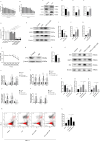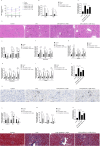Aquaporin 1 is renoprotective in septic acute kidney injury by attenuating inflammation, apoptosis and fibrosis through inhibition of P53 expression
- PMID: 39238634
- PMCID: PMC11374652
- DOI: 10.3389/fimmu.2024.1443108
Aquaporin 1 is renoprotective in septic acute kidney injury by attenuating inflammation, apoptosis and fibrosis through inhibition of P53 expression
Abstract
Sepsis associated Acute kidney injury (AKI) is a common clinical syndrome characterized by suddenly decreased in renal function and urinary volume. This study was designed to investigate the role of Aquaporin 1 (AQP1) and P53 in the development of sepsis-induced AKI and their potential regulatory mechanisms. Firstly, transcriptome sequencing analysis of mice kidney showed AQP1 expression was reduced and P53 expression was elevated in Cecal ligation and puncture (CLP)-induced AKI compared with controls. Bioinformatics confirmed that AQP1 expression was remarkably decreased and P53 expression was obviously elevated in renal tissues or peripheral blood of septic AKI patients. Moreover, we found in vivo experiments that AQP1 mRNA levels were dramatically decreased and P53 mRNA significantly increased following the increased expression of inflammation, apoptosis, fibrosis, NGAL and KIM-1 at various periods in septic AKI. Meanwhile, AQP1 and P53 protein levels increased significantly first and then decreased gradually in kidney tissue and serum of rats in different stages of septic AKI. Most importantly, in vivo and vitro experiments demonstrated that silencing of AQP1 greatly exacerbates renal or cellular injury by up-regulating P53 expression promoting inflammatory response, apoptosis and fibrosis. Overexpression of AQP1 prevented the elevation of inflammation, apoptosis and fibrosis by down-regulating P53 expression in Lipopolysaccharide (LPS)-induced AKI or HK-2 cells. Therefore, our results suggested that AQP1 plays a protective role in modulating AKI and can attenuate inflammatory response, apoptosis and fibrosis via downregulating P53 in septic AKI or LPS-induced HK-2cells. The pharmacological targeting of AQP1 mediated P53 expression might be identified as potential targets for the early treatment of septic AKI.
Keywords: AKI; apoptosis; aquaporin 1; inflammation; p53; sepsis.
Copyright © 2024 Lv, Liao, Li, Liu, Luo, Diao, Wang and Jin.
Conflict of interest statement
The authors declare that the research was conducted in the absence of any commercial or financial relationships that could be construed as a potential conflict of interest.
Figures








Similar articles
-
Endotoxin induced acute kidney injury modulates expression of AQP1, P53 and P21 in rat kidney, heart, lung and small intestine.PLoS One. 2023 Jul 25;18(7):e0288507. doi: 10.1371/journal.pone.0288507. eCollection 2023. PLoS One. 2023. PMID: 37490500 Free PMC article.
-
Aquaporin-1 attenuates macrophage-mediated inflammatory responses by inhibiting p38 mitogen-activated protein kinase activation in lipopolysaccharide-induced acute kidney injury.Inflamm Res. 2019 Dec;68(12):1035-1047. doi: 10.1007/s00011-019-01285-1. Epub 2019 Sep 16. Inflamm Res. 2019. PMID: 31529146 Free PMC article.
-
Upregulation of lncRNA NONRATG019935.2 suppresses the p53-mediated apoptosis of renal tubular epithelial cells in septic acute kidney injury.Cell Death Dis. 2021 Nov 1;12(8):771. doi: 10.1038/s41419-021-03953-9. Cell Death Dis. 2021. PMID: 34719669 Free PMC article.
-
The role of inflammatory response and metabolic reprogramming in sepsis-associated acute kidney injury: mechanistic insights and therapeutic potential.Front Immunol. 2024 Oct 31;15:1487576. doi: 10.3389/fimmu.2024.1487576. eCollection 2024. Front Immunol. 2024. PMID: 39544947 Free PMC article. Review.
-
A crucial role of miR-155 in the pathomechanism of acute kidney injury.Front Pharmacol. 2025 Apr 16;16:1570000. doi: 10.3389/fphar.2025.1570000. eCollection 2025. Front Pharmacol. 2025. PMID: 40308762 Free PMC article. Review.
Cited by
-
Aquaporins in sepsis- an update.Front Immunol. 2024 Oct 31;15:1495206. doi: 10.3389/fimmu.2024.1495206. eCollection 2024. Front Immunol. 2024. PMID: 39544938 Free PMC article. Review.
-
Exploring Aquaporins in Human Studies: Mechanisms and Therapeutic Potential in Critical Illness.Life (Basel). 2024 Dec 20;14(12):1688. doi: 10.3390/life14121688. Life (Basel). 2024. PMID: 39768394 Free PMC article. Review.
-
MSC-derived exosomes improve endometrial fibrosis via the lncRNA IGF2R/ miR-143-5p/AQP8 axis.Stem Cell Res Ther. 2025 Aug 27;16(1):464. doi: 10.1186/s13287-025-04611-z. Stem Cell Res Ther. 2025. PMID: 40866943 Free PMC article.
-
Development and validation of a machine-learning-based model for identification of genes associated with sepsis-associated acute kidney injury.Front Genet. 2025 Jul 22;16:1561331. doi: 10.3389/fgene.2025.1561331. eCollection 2025. Front Genet. 2025. PMID: 40765579 Free PMC article.
References
MeSH terms
Substances
LinkOut - more resources
Full Text Sources
Medical
Research Materials
Miscellaneous

